Greetings, readers of the Fandomentals. It’s me again, and this time, instead of complaining about this or that, I’m going to analyze, dissect and speculate on the lore behind the Dragon Age series. It’s a hefty topic, so I am going to narrow it down to the Blight and Darkspawn. Warning: spoilers for the entire series follow, entirely unmarked. Read at your own peril.
What We Know
In the first section of the article, I am going to cover what we definitely (or almost definitely) know about the Darkspawn, their corruption and origins. Later on I will let my imagination run wild as I speculate from indirect information.
The Darkspawn enter the series at its very beginning, in Dragon Age: Origins. They’re the major distinguishing feature of a game that’s otherwise a deliberately old-school “spiritual successor” to old titles like Baldur’s Gate, set in a decidedly generic setting.
The player’s character, regardless of their origin, becomes a Grey Warden – member of an order whose sole goal is to stop the Darkspawn. In keeping with the traditions of the genre, the senior Grey Wardens meet their ignoble deaths early on, leaving the protagonsist and a Grey Warden with only slightly more experience as the sole survivors who have to clean up all that mess.
Thus, the threat of the Darksapwn is the driving force of all the conflicts in the game. Even though we need to make alliances, navigate politics, and struggle against an usurper, all of it is either in preparation to fight the Blight, or a direct result of its looming presence.
Despite that, no one really knows that much about the Darkspawn. They first emerged hundreds of years prior to the game’s events. Coming from the underground, they almost annihilated the dwarven empire, leaving it with two cities. Then they turned their sights on the surface world and wreaked immense havoc. It ended when the first Grey Wardens devised a way to consume Darkspawn blood and immunize themselves to their corruption. This also allowed them to slay the Archdemon – a massive dragon-like Darkspawn that commands them.
After that, the Darkspawn retreated underground. They left the surface alone for years, except for occasional raids. Until they found another Archdemon and returned in numbers, in what was then called the second Blight. This repeated twice more, and the Blight we deal with in Origins is the fifth one.
We don’t get much in terms of knowledge about them in Dragon Age: Origins. We learn the story the Chantry tells about it: the first Darkspawn were the mage-rulers of the ancient Tevinter Imperium, who used their magic to bodily enter the Golden City in the Fade, in an attempt to usurp the Maker’s throne. For that, he cursed them and released them upon the sinful world as Darkspawn. The Magisters had been seduced into their attempt by the Old Gods of Tevinter, who took the shape of dragons. Thus, the Darkspawn seek the Old Gods underground and corrupt them.
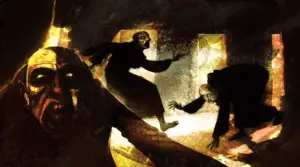
Some people believe it, others don’t. The player character has an option to express their opinion too. But ultimately, it’s an academic question in the face of a rampaging horde of corrupted monsters. The game ends with one of the Wardens slaying the Archdemon – an act that normally costs the Warden’s life as well. Whatever the Archdemons are, their soul seeks out another Darkspawn when they die. The Archdemon then restores itself in that body. If a Grey Warden deals the killing blow, the soul enters them instead. But since they’re not empty shells like Darkspawn are, the process kills them both. Unless you agree to Morrigan’s ritual and transfer the soul into an unborn child… which is a topic for another time.
Dragon Age: Awakening is an expansion to the original game that contains some very interesting lore and story, buried under pointless side-quests, broken gameplay, and an in-game economy that abandons all pretences of working. The plot centres around new, strange Darkspawn. Some of them can talk and reason like people – if often rather unhinged people.
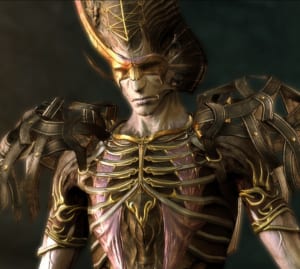
As it turns out, the one responsible for it is one called the Architect. An intelligent Darkspawn emissary, who also looks more human than most Darkspawn. He wants to free his kind from the call of the Old Gods and let them live in peace with others. With rather mixed results. What’s interesting is that he accomplished it by a sort of reverse Joining ritual – he had Darkspawn drink Grey Warden blood.
Unfortunately, he’s the one who caused the Fifth Blight by experimenting with Urthemiel, the Old God of Beauty. The Wardens can ally with him or kill him. Unfortunately, not much from the expansion ever becomes relevant in the future. Still, it raises some possibilities and confirms that the Archdemons are, in fact, Old Gods.
In Dragon Age 2, Darkspawn are of secondary importance. The game begins during the Fifth Blight, in Lothering – a small village the protagonist of Origins passes through before the Darkspawn destroy it. The protagonist, Hawke, and their family flee the village and make their way to the city-state of Kirkwall beyond the sea. There’s a one-year time skip between the prologue and the first proper act, and in that time, the Wardens stop the Blight.
You encounter Darkspawn now and again, as encounters in the wilderness and caves – and during an expedition into the Deep Roads, of course. Which is the limit of their presence between Blights.
That is, of course, until the Legacy DLC. In this content, Hawke and their sibling (if they’re alive) travel to a keep in the middle of nowhere. There, it turns out their father was blackmailed by the Grey Wardens into sealing a powerful Darkspawn with blood magic. The Darkspawn is now trying to get out, and sent dwarven criminals to obtain the blood of Hawke Senior’s offspring.
The Darkspawn turns out to have a name – Corypheus. Hawke and their rag-tag band of misfits finally reach his prison in time to see him wake up. He introduces himself as a Magister of Tevinter, unaware that the old Imperium is gone. Then he starts ranting and raving about… entering the Golden City. According to him, Dumat, the Old God of Silence, had promised him and the other Magisters that it would be golden, but they found it black and empty. He attacks the party and is slain in a boss fight… but it’s heavily implied that he hitched a ride in one of the Grey Wardens present.
His existence implies that at least part of the Chant of Light is true. The Magisters did enter the Golden City at the behest of the Old Gods. And they returned as Darkspawn. But what did they find there? Why was it black? What is the Black City?
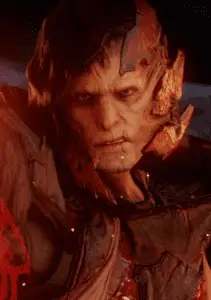
Those questions return with force in Dragon Age: Inquisition, along with Corypheus himself. The Magister is considerably more coherent, if not actually sane by any metric. He seeks to replicate his feat from long ago – breach the Veil, enter the Fade and claim the throne of the Maker. But this time, he’s not doing it for the Old Gods – he’s doing it for himself. He says that he saw the throne of the gods, and that it was empty, so he’s going to give Thedas a god it deserves.
If this sounds familiar, that’s because it is. Yes, the Architect from Awakening is clearly a Magister like Corypheus. He tells us that he was just different from other Darkspawn, and didn’t know why. That means he’s either lying, or genuinely forgot his old life. Just like Corypheus (or the Conductor of the Choir of Silence) was the high priest of Dumat, so was the Architect of the Works of Beauty the high priest of Urthemiel – the Old God of Beauty… coincidentally also the one he later woke up and turned into the Archdemon. Or maybe not coincidentally.
This is where our facts end. The Magisters Sidereal (as they’re called) were tempted by the Old Gods to enter the Golden City. The first whisper came from Dumat, to Corypheus. But the other Old Gods repeated the command. According to the Canticle of Silence in the Chant of Light, when the Magisters returned, the Archon of the Imperium scattered and banished them. Then Darkspawn bubbled out of the earth like a plague.
What I Take from It
The previous section compile the scraps of knowledge we have on the Darkspawn and the Blight that spawns them. From now on, I am going to speculate wildly, based on other bits of lore. Strap up, friends, because I might be as wrong as your relative who keeps posting conspiracy theories on Facebook.
Where do the Darkspawn really come from? It seems that they do indeed originate from the Magisters who entered the Golden City and returned bearing corruption. But that doesn’t really answer the question.
My speculation starts with the Titans. In the Descent DLC for Dragon Age: Inquition, we learn that they’re immense beings that once shaped the world, but are now asleep. The dwarves have a connection to them, which I’ll leave for another time. Lyrium is the titans’ blood.
The important part here is the relation of Titans to the ancient elves, and their “gods”. Who were actually just tyrannical mage-rulers that their people venerated as gods. Our first mention of the Titans actually predates Descent. If the Inquisitor drinks from the Well of Sorrows, they can decipher some writing:
“In this place we prepare to hunt the pillars of the earth. Their workers scurry, witless, soulless. This death will be a mercy. We will make the earth blossom with their passing.”
It’s fairly enigmatic at the time. However, it becomes much cleared after Descent... and after a certain hidden mosaic in Trespasser:
“Hail Mythal, adjudicator and savior! She has struck down the pillars of the earth and rendered their demesne unto the People! Praise her name forever!”
And then:
“What the Evanuris in their greed could unleash would end us all. Let this place be forgotten. Let no one wake its anger. The People must rise before their false gods destroy them all.”
If Descent was completed, the Inquisitor remarks:
“The runes say the Evanuris fought the Titans. They mined their bodies for lyrium and… something else. It’s not clear.”
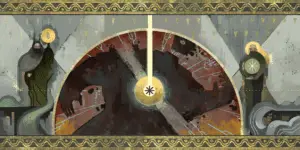
You can see where I’m going with this, can’t you? I think the terrible thing the Evanuris unleashed when mining the Titans’ bodies was, in fact, the Blight. To start with, what else could have threatened a civilization that struck down mountain-sized world-shapers? A civilization whose rulers were sorcerous god-kings and queens?
Another suggestion that pointed me towards this theory is something that we know very little about: the Forgotten Ones. They’re the evil deities of elven lore, figures of dread and hate. The Dread Wolf (also known as Solas and a know-it-all racist egg) supposedly locked them away, along with the Evanuris themselves. As we find out in Trespasser, the Dread Wolf did exist, and did seal away the Evanuris. What about the Forgotten ones? Well, I’d like to lean on the codex entry for Andruil on this.
“One day Andruil grew tired of hunting mortal men and beasts. She began stalking The Forgotten Ones, wicked things that thrive in the abyss. Yet even a god should not linger there, and each time she entered the Void, Andruil suffered longer and longer periods of madness after returning.
Andruil put on armor made of the Void, and all forgot her true face. She made weapons of darkness, and plague ate her lands.”
Andruil ventured into a dark place and came back corrupted. I do not think this is a coincidence. I think, in fact, that the Forgotten Ones were Darkspawn. Powerful, sapient Darkspawn like the Magisters Sidereal. The Blight would give them power to rival the Evanuris, and so they would go down as evil deities in elven legend.
That, of course, was before Solas created the Veil and banished the Evanuris. He makes no mention of the Forgotten Ones, but he does say that the Evanuris would have destroyed the world if he hadn’t stopped them. He also says that they’d killed Mythal for trying to stop them from something. And given the codex entry I quoted, it’s possible the Evanuris wouldn’t leave the Blight alone.
If my theory is correct, or at least not entirely wrong, it would mean Solas somehow quarantined the Blight in the Fade. Specifically, in the Black City. There are some hints that the enigmatic elf knows more on the subject than he lets on.
Solas: I find the fall of the dwarven lands confusing.
Varric: What’s so confusing about endless darkspawn?
Solas: A great deal, although that is a different matter.
That’s an odd reaction. Most people treat it in terms similar to Varric’s. The Darkspawn came, saw and conquered. It could be Solas being inquisitive, or it could be something else.
Another hint is Solas’ reaction to the scheme Corypheus manipulates the Grey Wardens into doing – summoning an army of demons and sending it to the Deep Roads to find and kill Old Gods before they can become Archdemons. He’s genuinely angry that they thought the Blight can be tricked. And he rarely shows strong emotion about something; he tends to mask them behind sarcasm and a veneer of detachment. Things that break the facade are slavery and abuse of spirits… or, apparently, Grey Wardens trying to take a shortcut. Again, this is flimsy. But maybe something’s up here.
So, if I’m onto something here, the Evanuris dug too greedily and too deep. But where did the Blight come from? This is where I’m going to speculate even more wildly.
I believe the Blight could be a primordial force of destruction that connects to the Titans somehow. Maybe it’s their anti-thesis. The Darkspawn corruption affects lyrium, turning it into red lyrium. We first find red lyrium in the Primeval Thaig in Dragon Age 2. It predates the First Blight, and yet, it contains an idol made of the substance.
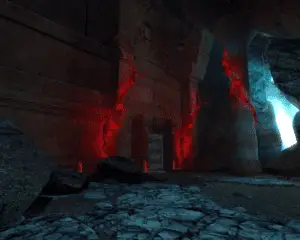
So the Blight might have been there before the Darkspawn emerged. And yet… why didn’t the corruption affect the lyrium in the Deep Roads after the Darkspawn overran them? Something doesn’t add up here.
Another sliver that adds to this line of thought is in Descent. To get to the Titan’s heart, the party heads below the Deep Roads, into a massive cave system filled with lyrium veins. Valta, a dwarf Shaper accompanying you, says that Darkspawn avoid it. Why? They don’t really show fear, or anything other than murderous rage, otherwise.
This isn’t a theory as much as following a vague thread of thought. What if the Blight is a force of destruction opposed to the Titans’ force of creation? Maybe it’s an imbalance created when the Evanuris struck them down. Then there’s the dwarven concept of gangue – impurities in the Stone. If the Titans are the Stone, or shape it… is the Blight such an impurity? One that went out of control when the Titans and their workers could no longer contain it?
What we Don’t Know
And here we come to the parts of the lore I can’t explain or theorize about just yet. First off, the Old Gods. How do they fit into all this? It’s my belief that the Old Gods were to dragons what the Evanuris were to elves – their god-like rulers. But that doesn’t explain why they’re asleep underground and why they tempted the Magisters to assault the heavens. What did they stand to gain from it?
We also don’t know why the Darkspawn seek them out. Evey creature afflicted with the Blight hears the Call of the Old Gods – the Darkspawn, the Grey Wardens and ghouls (unfortunate individuals who survived the corruption and became the Darkspawn’s slaves).
Why does this happen? I don’t know. The Architect describes the Call as “a never-ending aspiration towards a perfection they can never have” in The Calling. Could it be as simple as the fact that the Old Gods tempted the Magisters to the act that resulted in their corruption? Maybe the Darkspawn follow a warped echo of the desire that unleashed the Blight on the world. We don’t know. The Old Gods are a big missing piece of the puzzle that is the Dragon Age lore. What are they? What happened to them?
There’s also the mystery of what the Golden, or Black, City even is. Was it the seat of the Evanuris, stranded in the Fade when Solas split the worlds apart? If so, why did the Magisters release the Blight when they entered? There’s also a rather large gap between their return and the First Blight. The Magisters performed their ritual in Minrathous. But the Darkspawn later came from below, and attacked the dwarves first. Did they follow the Calling? The Architect and Corypheus don’t seem to have any compulsion to follow it.
I’ll leave you with this. Do you agree? Or you think I’m full of hot air? Maybe you have your own theories?

